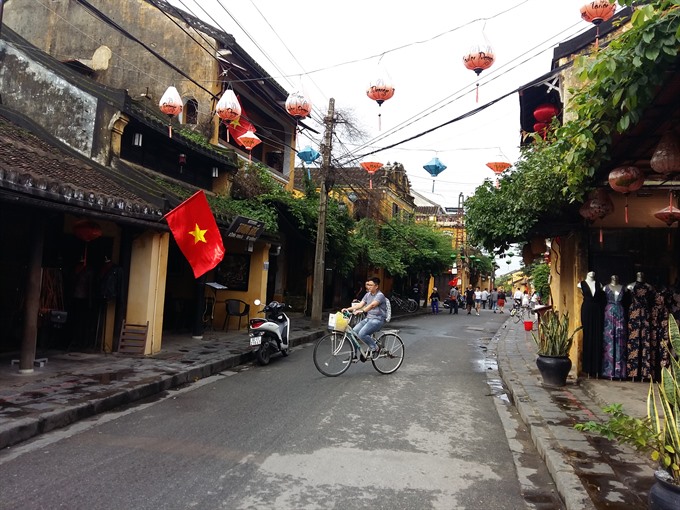 Society
Society

The ancient city has developed a master plan to boost the mass use of bicycles among community members and tourists, as part of efforts to make Hội An a capital of eco-friendly tourism in Việt Nam.
 |
| An old street in Hội An is reserved as a non-engine vehicle zone. The city plans to develop more spaces for pedestrians and bicycles. — VNS Photo Công Thành |
HỘI AN — The ancient city has developed a master plan to boost the mass use of bicycles among community members and tourists, as part of efforts to make Hội An a capital of eco-friendly tourism in Việt Nam.
Architect Đinh Đang Hải from HeathBridge Việt Nam said at a workshop on the development of a comprehensive bicycle plan in Hội An on Wednesday that more than 100 parks, communal gardens and neighbourhood sites have been built to create favourable conditions for pedestrians and cyclists.
The workshop, a prelude to the "Establishing a Comprehensive Bicycle Plan and Free/low-cost Bicycle Sharing Programme in Hội An City" project, was held in co-operation with HeathBridge Việt Nam and the city with funding from the German development agency (GIZ).
The project won the Global Urban Mobility Challenge Award of the Transformative Urban Mobility Initiative (TUMI) in Leipzig, Germany in May.
“Hội An is seen as the first urban locality in Việt Nam developing plans for non-engine transport and pedestrian streets,” Hải said.
He suggested that the city should build safe and connected paths for bicycles between schools, offices, shopping areas and markets as well as building priority lanes for bicycle users in shared traffic roads.
 |
| Visitors prefer walking or cycling to explore the old quarter of Hội An city. — VNS Photo Công Thành |
Jan Rickmeyer, an expert from GIZ, shared experiences from the successful story of bicycle development in Leipzig, Germany and the global trend in public and non-motorised transport, as bicycles in urban areas are often the fastest means of transport for trips less than 5km in distance.
He said the numbers of bicycle had doubled since1990 in Leipzig with more than 500,000 bicycles among the population of 600,000, while a total 460km of road was built for bicycle riders.
Jan said Leipzig also offered good connectivity among public transport vehicles including stations for bicycle parking, chargers for battery powered cars, taxis and busses.
Kim Lua from the World Resources Institute suggested that good design is the key to a safe biking environment in Hội An.
He said the city had seen a big change with 80 per cent of the population using bicycles in the 1980s, but the figure has now fallen sharply to 20 per cent.
He said bicycles now still fight for space with buses, motorbike and cars in the city’s daily traffic, and cyclists need safe lanes for riding.
Nguyễn Sự, former party secretary of the city, urged the city’s leaders to use bicycles for their daily commutes.
He said the city had designed several streets for pedestrians and non-engine vehicles to reduce noise and ensure people’s safety in the old quarter since 2002.
Sự said Hội An is a small city with many destinations within a 5km distance, and mass bicycle use could be possible.
The city also plans to provide 100,000 bicycles for residents in order to become the first eco-city in Việt Nam. — VNS




